Open Meeting Next Tuesday, March 11 Concerning Bahulaban
With the approval of the New Vrndavana Board of Trustees, a group of devotee investors, headed by Adi Guru das, NV resident, have formed a non profit religious corporation whose purpose is the restoration of the Bahulaban property. The Bahulaban farm was purchased in 1972 and was the home of Radha Vrndavana Candra until 1984. Srila Prabhupada’s main preaching activities centered in Bahulaban during three of his four visits to NV.
They have asked that a vision team be formed from amongst local community devotees as well as interested non resident parties to help set the direction and spell out do-able goals for them to execute. There will be an open meeting next Tuesday, March 11 at 6 pm in the Temple Prasadam Hall.
The purpose of this meeting is to stimulate discussion on this exciting development concept for Bahulaban and to form a vision team that can articulate a well thought out plan to the new corporation.
Everyone is Invited! Please Come! Prasadam Will Be Served!.
On The Cusp Of The Local Radio Revolution

New Vrindaban is on the front lines of a nationwide push for more access to low-power FM radio stations (LPFM), which has now been taken to the floor of the U.S House and Senate.
Check out this article which details the Local Radio Community Act, which will offer low-power, local airwave access to a whole range of diverse and progressive community groups that have been left out of the wrong side of media consolidation of the airwaves by powerful corporate interests like Clear Channel.
Most importantly, you can help! By clicking this link here, you can get in contact with your local elected officials and tell them to support local radio now!
Like may other local community groups across the country, we are hoping to acquire our own bit of bandwidth in order to provide an true spiritual alternative for radio-listeners in our own little slice of West Virginia and Ohio (and beyond via the Internet). You can check out an article on our petition here and a potential programming guide for our station here.
In Vrindaban
by Chakra Pani dasa, from the Sept. 1981 Issue of the Brijabasi Spirit
On July 12th, another phase of Vrindaban history opened. Big Lord Jagannath, feeling grievously homesick, decided to stay in VrinÂdaban after the culmination of the usual cold He usually gets at this time of the year. Not having room to sit next to Radha-Vrindaban Candra and Their ecstatic friends on the Bahulaban altar, He has decided to retreat to the oriÂginal Vrindaban forest.
Brijabasis know how to have a festival. SimÂply come to Vrindaban, and automatically, it is a festival. Kirtananda Swami briefly interrupted the sweaty, ecstatic installation kirtan to explain what glamour this shanty-like farm was for us. Many of the devoÂtees there were initiated in the Vrindaban farm scene. Bodies were packed in the temple room like canned peas, and the heat was intense. Kirtananda Maharaja, pointing his finger toward the upper level, declared to Sridhar Maharaj that Prabhupada had spent a month right there, making Vrindaban an extra special place. “When Srila Prabhupada saw that we had cow dung on the kitchen floor, he was very pleased.” Maharaja stated. “He used to take His bath right out there in the meadow. Prabhupada once told us, “A man could go out all day, work hard and come back with ten dolÂlars. But if a man simply stays in one place, using his intelligence, he can make one hundred dollars a day.” Similarly, by staying here in one place, living simply and thinking purely, we can make people come to us. There is no need for us to travel far and wide. Now Krishna is giving us so much facility for spreading Krishna conÂsciousness with an opulent palace and so much land. If we simply stay in this one place and chant and remember Krishna everything will come.
Most likely, I was not the only person in the room experiencing a dire thirst amid the heat and scarce air. This thirst was satisfied, however by the sweet, cool katha coming from Kirtananda Swami. Also during the heat of the kirtan, considerations of comfort were tranÂscended by the “ocean of bliss” we were tapped into.
In Vrindaban, the gopis had Rasa-lila with Krishna. Out of pure affection, without hesiÂtation, they sacrificed all mundane consideration to please Krishna. To experience the love they had for Him, Krishna incarnated five hundred years ago with the first amongst the gopis, Radharani, and took the form of Sri Krishna Caitanya Mahaprabhu. In the mood of Radharani, He has shown His most sublime causeless mercy by appearing in this dark age of Kali and inaugurating the Sankirtan movement.
We spread Krishna-lila by dancing, and by the chanting of His holy name: Hare Krishna, Hare Krishna, Krishna Krishna, Hare Hare, Hare Rama, Hare Rama, Rama Rama, Hare Hare. Although we’ve committed the most abominable activities, in this age we can also enter into the Rasa-lila with Krishna by engaging in the kirtan and giving up sinful dealings. To estabÂlish a foundation for His movement, Lord Caitanya excavated the old Vrindaban in India where Krishna originally performed His past-times on this planet. His principle associates deÂveloped it as the center for Krishna-bhakti by building wonderful temples and writing literÂature on Vaisnava behavior.
Now, in the last few decades, Srila Prabhupada with the help of his disciples has expanded this movement around the globe so that not just in India, but everywhere, practically everyone has heard the name of Krishna. He has deputed his disciple, Kirtanananda Swami to establish this New Vrindaban in America so that Westerners will also have a holy place to make pilgrimage and come closer to
Krishna. It is offensive to consider the boundÂaries of Vrindaban to be limited. Wherever a sadhu stays and glorifies Krishna, there is where
Krishna is performing His pastimes. Therefore Prabhupada stated that this New Vrindaban is non-different from the old VrinÂdaban. In a letter to Kirtananda Maharaja, written during the first years of it’s founding, PrabhuÂpada told him that due to his pure devotional service, Krishna had followed him to this place.
It was here, on this remote ridge that New Vrindaban was established. Mountain living was new to the original devotees, who settled here. Being conditioned by years of city conÂveniences, all of them left during the winter months, except for Kirtananda Maharaja. LivÂing for months on only oats and roots he dug from the ground, Kirtananda Maharaja made garÂlands for his deities with colored leaves and berries or whatever he could find. He gradÂually attracted others by his determination. In that same letter, Prabhupada declared, “Just be steady in your deity worship, chant your sixÂteen rounds early, before you do anything else. Then Krishna will be pleased and He will send others.”
Only a handful of the approximately three hundred and fifty devotees who now reside in New Vrindaban crowded into the small, hot temple room where it all began, but that did not dampen the enthusiasm of the dancing devotees upon the occasion of Lord Jagannath’s reinstallation. Kirtananda Maharaja said, “This farm too will be part of the whole scheme for Krishna-land. Besides Srila Prabhupada’s Palace and Radha-Vrindaban Candra’s new temple, there will be the seven principal temples of Vrindaban built on the farm. Within a one or two mile radius, visitors will be able to do Parikram and see all the principle sites of Vrindaban.”
The original farm has gone through phases since the beginning. To realize the goal of building Krishna Land, it became necessary to centralÂize the community’s activities in the less remote location of Bahulaban farm. Vrindaban farm became known as the place of pilgrimage within the place of pilgrimage, because Srila PrabhuÂpada had lived there a month, and Kirtananda Maharaja, by his austerities and devotion attracted Krishna to that place.
Krishna’s personal presÂence can especially be felt by the devotees who lived there or visited the “city.” (BahuÂlaban) For five years, until the first grand openÂing festival for the Palace in ’79, it had been the resting place for Radha-Vrindaban Natha and most of the brahmacaris on the farm. Atmabhu Maharaj, who had been the temple president and construction manager extraordinaire for most of this period, said that “without the seÂclusion this farm had afforded to us, the Palace would never have been built.” Kirtananda Maharaja says, “Staying in this one place, we shall change the whole world.” Indeed, although one’s reÂspective social position may change, the simple brahmacari life which has been exhibited here seems most natural for the soul. If we can duplicate this mode of simple life and high thought as far as possible, then we shall be admitting others into this land of Vrindaban, whose boundÂaries are not limited.
Since Krishna never leaves Vrindaban, it is no surprise that Lord Jagannath chooses to appear and reside there. The devotees, in the mood of separation may appear to have lost their sight of Krishna in Vrindaban, but actually, how can we ever take Vrindaban out of our minds.
Winter Clings To New Vrindaban
With temperatures averaging 10 degrees below normal and lots of snow, winter remains attached to New Vrindaban.
Last night was a windless snow and every surface including branches is covered.
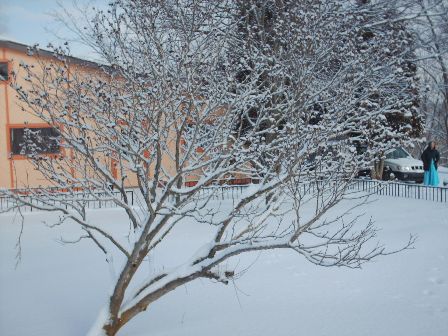
“Prabhupada: This is innate truth: as three angles of a triangle are equal to 180 degrees, similarly snow is white. Snow is white, water is liquid, stone is hard, chili is hot, sugar is sweet. These are eternal truths, fundamental truths. Similarly, a living entity is eternal servant of God.
“This is eternal truth. It cannot be changed. Water is liquid. That is the natural position, but when water becomes hard, it is due to temperature, under certain conditions, but as soon as the temperature reduces, the water becomes liquid. So liquidity of water is truth.
“Similarly, whiteness of snow is truth. Similarly, servitude of the living entity is truth. But he is serving maya. That is untruth. If we take that there are two types of truth, there cannot be two kinds of truth. Truth is one. What we take as truth, that is maya.”
Discussions with Shyamasundara das: Gottfried Wilhelm von Leibnitz
Vendor Opportunities For FOI
by Malati dd
There is limited opportunity for vendors of quality items at Festival of Inspiration, May 9th, 10th, 11th in New Vrindaban. We especially are looking for Prasadam Vendors (If you have something good, healthy, and quick to go, I guarantee that you will not be disappointed.) Please contact:
for further information.
One thing to note is while there is limited shared accommodation facility for vendors, all on site accommodation has been fully booked at this time. If you plan on bringing friends and family, you will need to bring a camper, a tent, a van, or book a hotel room. (see our web site for list of nearby hotel/motels)
http://festivalofinspiration.org/
Getting the New Vrindaban Experience
This past weekend, two intrepid reporters from Ohio University’s student-run indepedent newspaper The Post, Rob (the photographer) and Eric (the reporter), visited the Dham in order to meet devotees and do research for their thesis paper on the inner workings of an intentional community (they are also visiting a Mennonite community, an all-woman community, and a long-standing commune outside of Athens, Ohio).
Sri-Sri Radha-Vrindaban Chandra graciously arranged a very complete and positive experience for our visiting friends, as they got to witness the inner workings of deity seva, a tour of the Palace of Gold, and they heard all about the radical community-based organic farming spearheaded by HG Tapahpunja Prabhu and his Small Farm Training Center.
We shared songs and lessons with HG Devananda Pandit Prabhu, and great maha-prasad all weekend. Best of all was a Sunday morning trip to the ISCOWP barn and a very enlightening get-together with HG Balabadha Prabhu, who passed along all the wisdom he knows about the deep merits of cow protection.
Rob and Eric both remarked numerous times that the devotees here gave them the best experience they’ve had in their various visits to the different communities on their list. Below is some pics of their visit to the ISCOWP barn.
Rob has a loving exchange with Balarama
Kow-Katha
by Taru dasa, from the February 1978 Issue of the Brijabasi Spirit
ISKCON’s champion milker, Sarasvati, came fresh for the fourth time in the beginning of January. Last lactation she established, at 116 pounds, the record for one day’s production for an ISKCON mother. This season she set out rapidly to demolish all her previous records. Within two weeks she had topÂped 120 pounds, the new record rising to 125.
Now I’ve been out of the barn for about a year, my current engagement being as a plasterer. But I started hanging out at the barn around milking time just to see Sarasvati do it. I have to admit that she gets more beautiful each year. Old fans of the Spirit may recall earlier descriptions of her rascaldom back in her days as a heifer. Now she’s as mild as can be, so busily engaged in making milk. You won’t find a nicer milk bag anywhere—it’s like the artist’s concepÂtion of an ideal udder. It’s perfect in size and shape and is supported quite firmly. Although it puts out so much milk, it isn’t overly large on Sarasvati and she wears it quite comfortably. You wouldn’t guess she was putting out 14-16 gallons per day.
While the average cow is milked twice a day, Sarasvati is milked three times to relieve the strain on her bag. One mornÂing Amburish stopped by and told me she had cranked out 91 pounds in the first two milkings. So of course I was on hand for the day’s finale. Everyone was hoping for her to clear 130.
Well, Tapomurti pulled the old milkÂer off her and emptied it into a pail. I was checking her rear teats and felt there was more in there. So Amburish came over and squeezed a little and, sure enough, extracted another 4 or 5 pounds from her magic bag. We then weighed it and totaled the day to find she had hit 138 pounds, 13 pounds highÂer than the previous record! By the merÂcy of Providence I got in on a little bit of the action.
Last year we announced our first annual cow awards for 1976. ContinuÂing in this tradition, here are the awards for 1977.
COW OF THE YEAR: Sarasvati (who else?). Milking up to 300% higher than the daily average for the rest of the herd, Sarasvati amassed 20,500 pounds of milk in 305 days from October of ’76 to August of ’77. She got her picture taken with Kirtanananda Maharaja and receivÂed numerous garlands from her admirers. She is given all she can eat as a reward and she readily converts all such feed inÂto more and more milk. Who could ask for anything more-and don’t say carob milk!
ROOKIE OF THE YEAR: Shakti. The first daughter of (who else?) SarasÂvati, Mother Shakti made her debut by giving more milk in her first year than Saracvsti did in her first year. Following in her mother’s hoofprints, she was very fond of kicking would-be milkers in the head and had to have her legs tied up a lot. But for a nice supply of nectarean milk, who would be unwilling to accept a little austerity?
MOST IMPROVED COW OF THE YEAR: Citralekha. This is our one and only
Guernsey cow, probably because she did so bad her first year. Factually, no one milked her-we just stuck her in with the calves and let them get what they could. Now she has developed a truly admirable udder and we’re all waiting to see how nicely she’ll do. By the way, she puts out the hugest calves which can only be compared to a human mother’s delivering a 25 pound baby.
SMOOTHEST MILKER: Cancala. A few days ago the power went off and we got to milk by hand, like in the old days. Cancala’s easy delivery reminded me of Mallika, who gave milk the way a faucet gives water. It was confirmed by the boys who milk her every day that she’s the fastest of all.
MOST HUMOROUS BAG: Surabhi. Imagine a large beach ball which is a little soft. Now poke your index finger into it so far that it’s completely engulfÂed. Well, that’s just what Surabhi’s teats look like. You can hardly see them as her loosely supported bag droops down all around. Up close though, don’t laugh too hard. She likes to kick a lot.
THE COW I’D LEAST LIKE TO BE STRANDED ON A DESERT ISLAND WITH: Lila. Better known as ‘Hurricane Lila,” she continues to defy the rule that a cow’s temper quiets down after she’s had a few calves. The quickness, accurÂacy and ferocity of her hind legs makes one wonder how a bull ever managed to breed her.
THE OLD PRO AWARD: Pritha, putting out her seventh calf in seven years, is about the oldest milker still in action. Old Dudya exceeds her age, but Dudya hasn’t given a drop in the last four or five years. Pritha’s just the typÂical cow, the one you’d never notice, she’s so plain and simple. Practically everyone learned how to milk on her, including me.
We’d also like to mention that the herd topped 300,000 pounds last year and just ‘last week we went past the 1,000,000 pound mark (since we started keeping records in 1974).
Cows are people. The cows in Vrindaban may even be liberated souls. Who can say? In any case, it’s a lot more fun than going to the A & P and picking up a little square box out of the dairy freezer. It’s nice to know that the milk came from a friend of Krsna’s.
More On The Fire at RVC Temple
Right now the only real damage is to a series of spots on the temple floor that have been warped by the water, but it certainly is repairable, and we are also working on getting some maintenance to our trusted sprinkler system, which saved the day during the fire and has likely guaranteed itself a trip back to Godhead once its earthly life is over.
We followed up with an isthagosthi the day after the fire, and we are now implementing some changes in ashram policies (putting up fire safety signs in each room, banning incense burning, etc). All in all, it’s an event that wakes up everybody living in the temple to the need for responsibility and community.
Last and not least, here are some pics….
Incense + this chair=fire
Local heroes The Limestone Volunteer Fire Department rush to the scene
Devotees band together to clean up the temple floor
The Path of Yogamaya
by mrupa
Dropping down from the main road just in front of the old one-room school house next to the lagoon and across from the old forge, the first few yards of dirt road is both the beginning of the driveway to Mr. Snyder’s homestead along the top of the ridge, and the pathway to Vrndavana Farm.
Like Krsna at the Rajasuya Sacrafice, it was seen by many different people in many different ways; from an expansion of Aghasura to one of Yogamaya. The road definitely bore the touch of the internal energy though, for it led you to Krsna and His original abode here in West Virginia anyway. It was traversed by the Planter of the transcendental seed of Goloka, Srila Prabhupada; and is a place of some of His sweet pastimes.
The path through Keshi Ghat was mostly the result of running the electric wires from the main road to the Vrndavana farmhouse which originally had no wiring at all. But when Prabhupada said He wouldn’t come unless he could keep on using His dictaphone for His translations, the yajna through the valley behind the farmhouse was “opened†up.
The road was a narrow dirt pathway, barely wide enough for one car that was the only access to Vrindavana Farm-the original property constituting New Vrindavana.
At first as you left the main road on the way “up top,†you bore right off of Mr. Snyder’s driveway and dropped slightly onto a lower arm of the track. A small lively creek runs along your right side just a few feet from the walkway. Along the upper left hand side is a wire and wood post property line fence indicating the lower line of Mr. Snyder’s land. It is often hidden as it raises and lowers its way along the ridge-side.
These first few sections of the road, flat with easy entry and with the creek curving around it, have been used as the backgrounds for some of the early artists’ paintings of Krsna and His associates.
The creek meanders back and forth crossing the walkway three different times. Its widest crossing is at a slight bend in the road just the road begins to rise upwards in curving undulation toward the cliffside site of Vrindavana Farm. As the road rises there, the creek begins to drop along the fold of the land gradually at first. Until it is running many many yards below the embankment of the road; first through one small waterfall far out and down behind Lalita Gopi’s home, (just before the pond now at the bottom of the access road across from Vani’s home) and over the Kesi Ghat fall below Vrindavana Farm Itself.
In the summer time on the lower flatter stretches of the road, the plants would tower up and lean over the edge of the road, in a few places from both sides. The fragrance of their flowers, the warmth they generated, and the way they blocked your vision of anything else for that stretch, made you feel like some small thing wandering in a gigantic greenhouse, or perhaps along the path of some new planet.

Welcome to Brijabasi Spirit
Thank you for taking the time to visit the New Vrindaban community blog. Think of visiting our blog as making a virtual pilgrimage.
Hare Krishna Hare KrishnaKrishna Krishna Hare Hare
Hare Rama Hare Rama
Rama Rama Hare Hare
"May cows stay in front of me; may cows stay behind me; may cows stay on both sides of me. May I always reside in the midst of cows."
Hari Bhakti-vilas 16.252

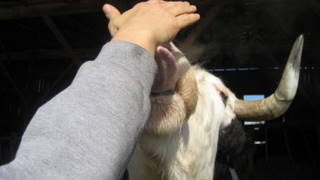
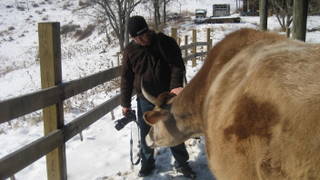
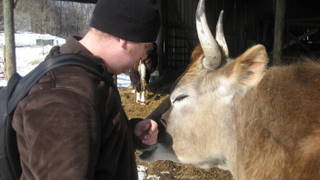

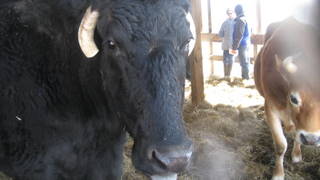
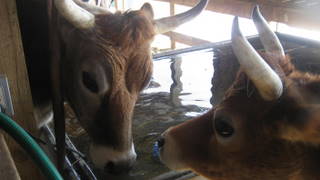
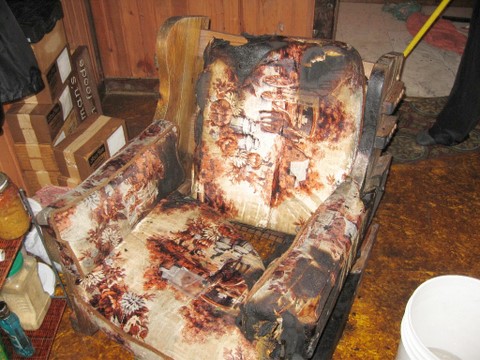
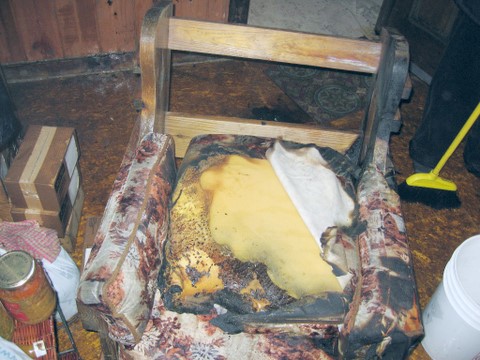
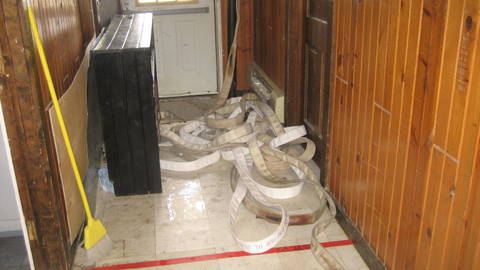
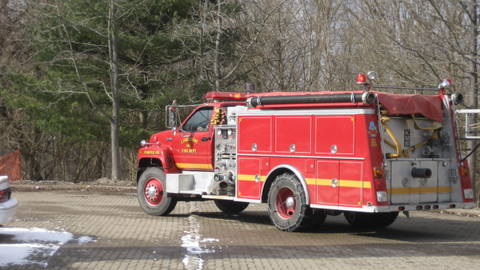
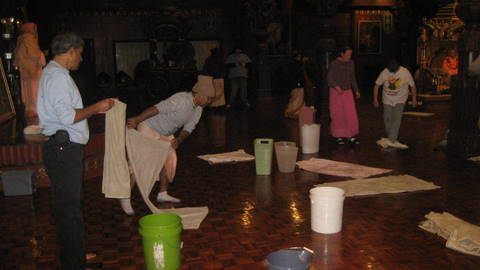
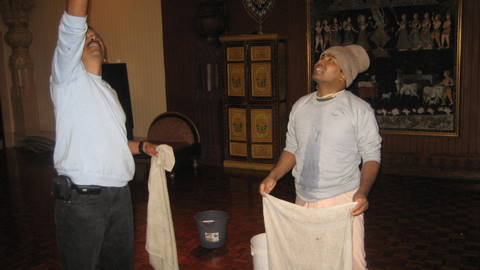




Recent Comments